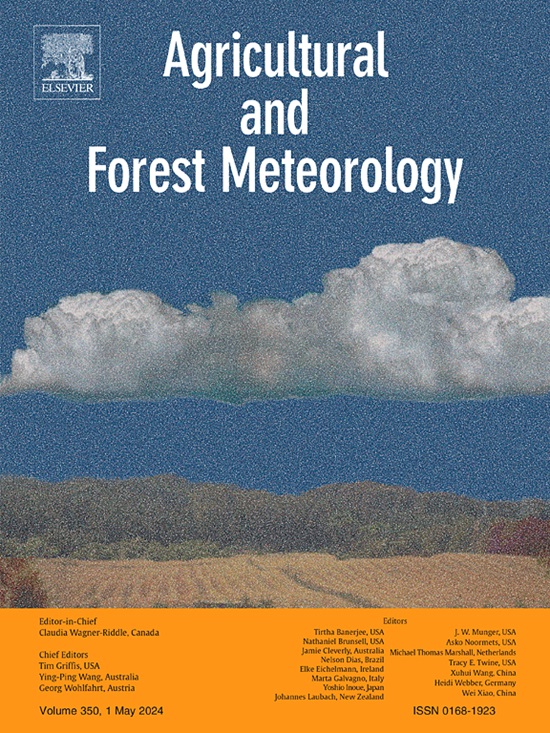Shifts in soil freeze-thaw cycle and their climate impacts along the alpine wetland-grassland continuum
IF 5.6
1区 农林科学
Q1 AGRONOMY
引用次数: 0
Abstract
Climate change and human activity have profoundly altered soil hydrology, reshaping the areal extent and boundaries of wetland ecosystems. However, the impact of these shifts on the soil freeze-thaw cycle and their subsequent influence on greenhouse gas emissions remains poorly understood. This knowledge gap is particularly critical in high-latitude and high-altitude regions, which harbor substantial carbon stocks and exhibit distinct seasonal soil freeze-thaw cycles. Here, we conducted year-round field monitoring of the soil freeze-thaw cycle along an alpine wetland-grassland continuum on the Tibetan Plateau. We found that as the landscape transitioned from mesic meadow to wet meadow and then to fen, soils tended to freeze later (with delays of 4 and 24 days, respectively), more slowly (with reductions of 55.8% and 45.7%, respectively), and at shallower depths (with reductions of 59.7% and 57.8%). By combining high-resolution greenhouse gas carbon flux and energy exchange monitoring, we further found that soil thawing increased CO2 and CH4 emissions, inducing pronounced positive climate-carbon feedbacks, which were stronger in magnitude than the negative climate-carbon feedbacks associated with soil freezing (+632.1 vs -183.1 g CO2-eq m-2). In contrast, both soil thawing and freezing resulted in significant negative climate feedbacks due to net reductions in sensible and latent heat fluxes. These findings underscore the critical role of hydrological-driven shifts in the soil freeze-thaw cycle, highlighting their interactive effects on climate-carbon and climate-energy feedbacks.
高寒湿地-草地连续体土壤冻融循环变化及其气候影响
气候变化和人类活动深刻地改变了土壤水文,重塑了湿地生态系统的面积范围和边界。然而,这些变化对土壤冻融循环的影响及其随后对温室气体排放的影响仍然知之甚少。这种知识差距在高纬度和高海拔地区尤为重要,因为这些地区拥有大量的碳储量,并表现出明显的季节性土壤冻融循环。本文对青藏高原高寒湿地-草地连续体土壤冻融循环进行了全年野外监测。结果表明,从中草甸到湿草甸,再到沼泽,土壤冻结时间延迟4 d、24 d,冻结速度慢(分别减少55.8%和45.7%),冻结深度浅(分别减少59.7%和57.8%)。通过结合高分辨率温室气体碳通量和能量交换监测,我们进一步发现土壤融化增加了CO2和CH4的排放,诱发了明显的气候-碳正反馈,其强度大于土壤冻结相关的气候-碳负反馈(+632.1 g CO2-eq m-2 vs -183.1 g CO2-eq m-2)。相比之下,由于感热通量和潜热通量的净减少,土壤融化和冻结都导致了显著的气候负反馈。这些发现强调了水文驱动的变化在土壤冻融循环中的关键作用,强调了它们对气候-碳和气候-能量反馈的相互作用。
本文章由计算机程序翻译,如有差异,请以英文原文为准。
求助全文
约1分钟内获得全文
求助全文
来源期刊
CiteScore
10.30
自引率
9.70%
发文量
415
审稿时长
69 days
期刊介绍:
Agricultural and Forest Meteorology is an international journal for the publication of original articles and reviews on the inter-relationship between meteorology, agriculture, forestry, and natural ecosystems. Emphasis is on basic and applied scientific research relevant to practical problems in the field of plant and soil sciences, ecology and biogeochemistry as affected by weather as well as climate variability and change. Theoretical models should be tested against experimental data. Articles must appeal to an international audience. Special issues devoted to single topics are also published.
Typical topics include canopy micrometeorology (e.g. canopy radiation transfer, turbulence near the ground, evapotranspiration, energy balance, fluxes of trace gases), micrometeorological instrumentation (e.g., sensors for trace gases, flux measurement instruments, radiation measurement techniques), aerobiology (e.g. the dispersion of pollen, spores, insects and pesticides), biometeorology (e.g. the effect of weather and climate on plant distribution, crop yield, water-use efficiency, and plant phenology), forest-fire/weather interactions, and feedbacks from vegetation to weather and the climate system.

 求助内容:
求助内容: 应助结果提醒方式:
应助结果提醒方式:


